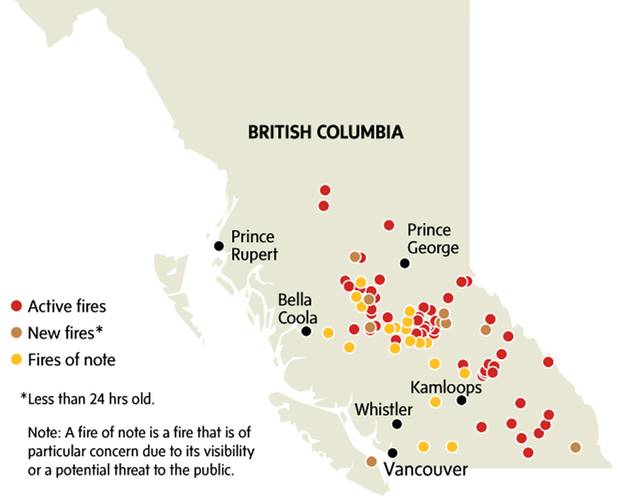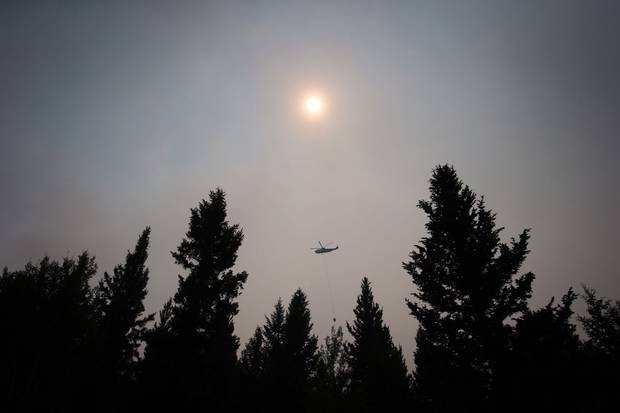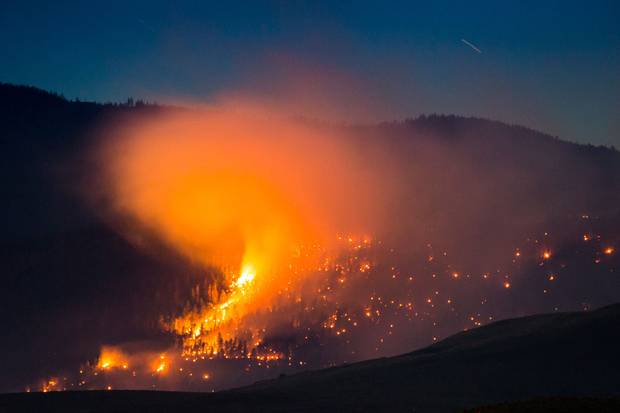The basics
- An evacuation order for residents of Loon Lake was lifted, a month after one of the largest wildfires this year. The owners of more than 300 properties have been allowed to return to their community in B.C.’s Interior that was once at the heart of the flames.
- The province has seen 904 fires since April 1, most of which prompted the state of emergency declaration on July 7, according to chief fire information officer Kevin Skrepnek
- B.C. is still in a state of emergency as about 150 wildfires continue to burn across the province, mostly in the central and southern Interior. Hundreds of firefighters from B.C. and beyond have been deployed to combat them.
- A rapidly moving fire near Monte Lake, east of Kamloops, prompted the Thompson-Nicola Regional District to declare a local state of emergency on Wednesday night and issue two evacuation orders covering about 60 properties.
- Fighting the fires and rebuilding afterward has been a major test for the new NDP government, which was sworn in on July 18. Premier John Horgan extended the provincial state of emergency. In his cabinet, Mr. Horgan named Doug Donaldson the new Forests Minister, the person in charge of the B.C. Wildfire Service, succeeding John Rustad in that role.
- On July 25, Mr. Horgan met Prime Minister Justin Trudeau for the first time in Ottawa discussed the wildfires, the Canada-U.S. trade dispute over softwood lumber and other issues.
- About 19,000 people are still displaced by the fires and have flooded into evacuation centres in Kamloops and elsewhere. During the worst phase of the fires, more than 45,000 people had been evacuated from their homes.
- Roughly 10,000 residents of Williams Lake are hopeful they will be allowed to return sometime soon.
- Fire bans are in place in many areas of neighbouring Alberta as hot, dry conditions raise the risk of wildfires. Parts of Alberta and Saskatchewan are under air-quality advisories as smoke from B.C. spreads east.
- The Red Cross is collecting donations here to help families displaced by the fires. To make a $10 donation by phone, text “FIRES” to 45678. Donations to the Red Cross are now accepted at all B.C. Liquor Stores and Canadian Tire locations.
Emergency information
For the latest information on current wildfires, road closings and air quality advisories, visit B.C. Wildfire Service and Emergency Info B.C. Follow the hashtag #BCWildfire for more information.
Information about the whereabouts of hospital patients relocated due to the fires is available at 1-877-442-2001.
Evacuees can register with Red Cross by calling 1-800-863-6582.
Individuals who have been displaced can go to any pharmacy in B.C. for refill or replacement prescriptions, according to a B.C. Pharmacy Association media release.
Where are the fires?
The biggest fires have driven thousands from their homes in or near Ashcroft and Williams Lake. Here is the B.C. Wildfire Service's latest list of active fires.
Location of fires on July 18:

THE GLOBE AND MAIL (SOURCE: BC WILDFIRE SERVICE)
Areas where an evacuation order is in effect:
- 150 Mile House
- Alexis Creek
- Ashcroft
- Big Bend Creek
- Clearwater
- West of Dunn Lake and north of Dunn Lake
- Fox Mountain
- Fraser River
- Grizzly Lake
- Gustafsen
- Hallamore Lake
- Hanceville
- Kleena Kleene
- Lexington subdivision
- Soda Creek
- South of Chilcotin River to Fletcher Lake
- McLeese Lake
- Miocene
- Monte Lake area properties
- Moore Mountain
- Polley Lake
- Precipice Creek (Stillwater Lake/Hotnarko)
- Spokin Lake Rd
- West of Tatelkuz Lake
- Thuya Lake Road
- Wildwood
- Williams Lake
Areas where an evacuation alert is in effect:
- 100 Mile House
- 100 Mile Fringe Southwest Davis Rd Area
- Dragon Mountain
- Finger Lake
- Forest Grove
- Green Lake South
- Big Creek area
- Kluskus area
- Loon Lake
- Little Fort
- Naltesby Lake
- Areas around Princeton
- Sutherland
- South Lakeside
- Tatuk Lake
- Tatelkuz Lake
- Wells Grey County properties
Areas where evacuation orders or alerts have been lifted:
The relief effort
B.C.: Outgoing premier Christy Clark announced a $100-million fund to help communities and residents rebuild. Shortly after taking office, new Premier John Horgan authorized a second payment of $600 for British Columbians who are kept out of their homes for more than 14 days. Public Safety Minister Mike Farnworth said Thursday that the Liberals' $100-million fund is enough to cover costs for now and the province is ready to spend more if necessary.
Ottawa: Federal Public Safety Minister Ralph Goodale has responded to B.C.'s appeals for federal help. The Canadian Armed Forces are helping residents affected by evacuations, airlifting emergency workers and equipment and providing relief to exhausted police forces in Williams Lake.
Alberta: B.C.'s neighbour province has sent about 100 firefighters to combat the flames, along with another 60 people with experience in co-ordinating firefighting efforts. Alberta Premier Rachel Notley has said that her province understands all too well the toll wildfires can take: Last year, nearly 10 per cent of Fort McMurray was destroyed by a wildfire. This summer, residents of Fort McMurray have sent tonnes of supplies, including water, Gatorade and baby supplies, to B.C.

July 8, 2017: Smoke obscures the sun as a helicopter carrying a bucket battles the Gustafsen wildfire near 100 Mile House, B.C.
DARRYL DYCK/THE CANADIAN PRESS

July 9, 2017: A burnt tree is seen in the foreground above the remains of mobile homes destroyed by wildfire in Boston Flats, near Ashcroft, B.C.
DARRYL DYCK/THE CANADIAN PRESS
Why is this happening?
A two- to three-week stretch of hot, dry weather left the province vulnerable to fire by July 7, when "a fairly significant weather system" brought heavy wind, according to Kevin Skrepnek, B.C.'s chief fire information officer.
Lori Daniels, an associate professor of forest ecology at the University of British Columbia, told The Canadian Press that several factors have left B.C. more fire-prone than in the past:
B.C. is too good at fighting fires: Firefighting efforts over the past 60 to 100 years have allowed for denser forests with a lot of dead material on the ground, Prof. Daniels says. Now, when the province has hot, dry weather and lightning strikes or there is a human ignition, the fires are much more severe and fast-moving.
Dry seasons are starting earlier: Prof. Daniels said in the past, the fire season began around the third week of July with the majority of fires starting in August. But over the past decade, B.C. has seen several years where hot and dry weather has begun earlier in July. It's hard to tell with certainty whether climate change is the culprit, but the current patterns are consistent with climate-change predictions for fire activity made 20 years ago, Prof. Daniels says:
We are on the path that was projected related to climate change. And as we look to the future, the kinds of fire weather conditions we have now that we consider extreme, when we project forward based on climate change predictions, they become more like our average conditions. This is very disconcerting and it is a serious concern for us.
Mountain pine beetles: Prof. Daniels said the mountain pine beetle also made B.C. forests more susceptible to fires, resulting in many dead trees that dried out and fell to the ground, creating more fuel for flames.
How bad is this? Some historical context
The fires' spread in early July was swift and brutal. From April 1 to July 19, B.C.'s wildfire season burned some 354,000 hectares of land. That's still smaller than the Fort McMurray fire, which burned 589,000 hectares – an area bigger than Prince Edward Island – and, at $3.7-billion, was the most expensive Canadian disaster ever, as measured by insurance providers.
What you can do
Get prepared: If you're a B.C. resident whose community is at risk for wildfires, here are the B.C. government's guidelines to prepare in advance before an evacuation and prevent more fires from starting.
#BCwildfire: A good emergency kit, via @PreparedBC. Chargers, maps, water, etc. pic.twitter.com/58uZlres5a
— Andrea Woo | 鄔瑞楓 (@AndreaWoo) July 9, 2017
Stop starting new fires: About half of the fires reported in the province this year have been caused by humans, despite campfire bans and steeper penalties. John Innes, dean of the faculty of forestry at the University of British Columbia, told The Globe a significant number of fires are simply the result of carelessness – campfires not properly extinguished, cigarettes thrown from cars, ATVs going through dry grass.
Donations: The Red Cross is collecting donations here to help British Columbians during the disaster.
With reports from Andrea Woo, Mike Hager, Xiao Xu, Brent Jang and Evan Annett
MORE FROM THE GLOBE AND MAIL



